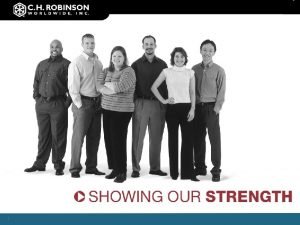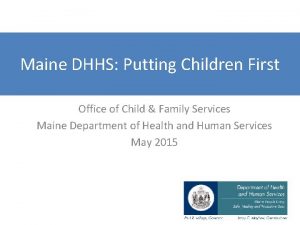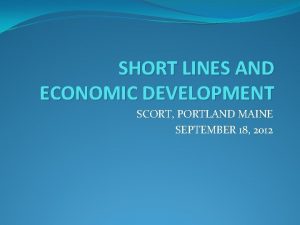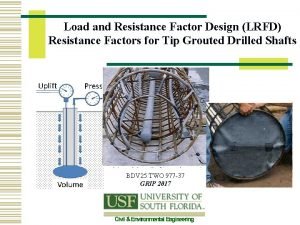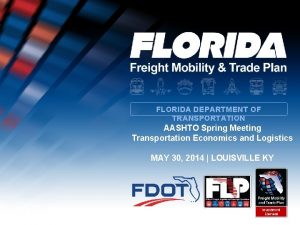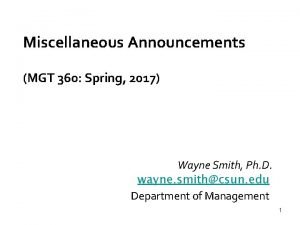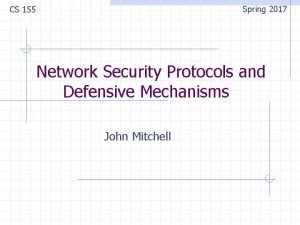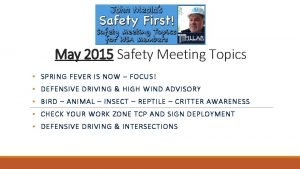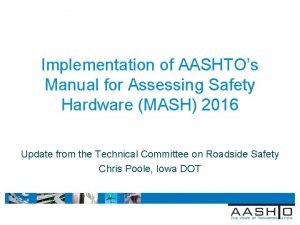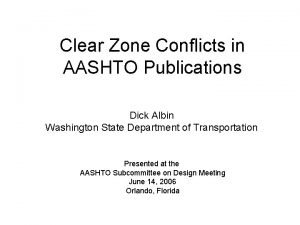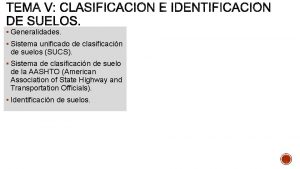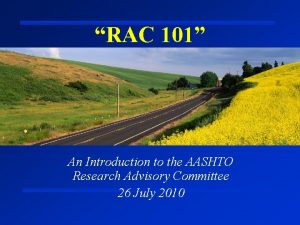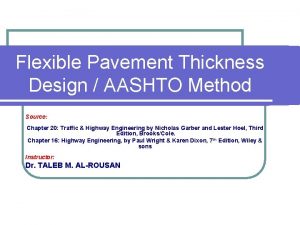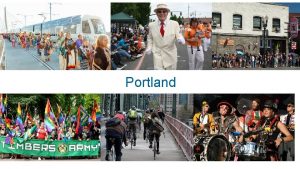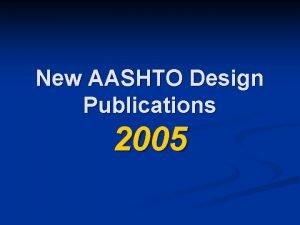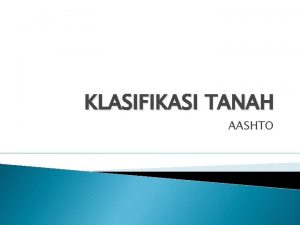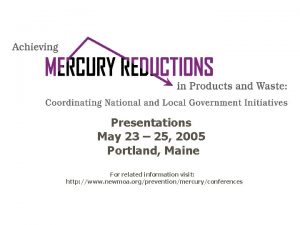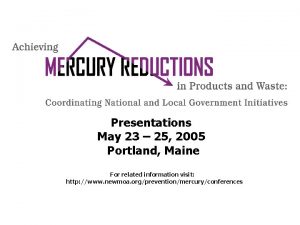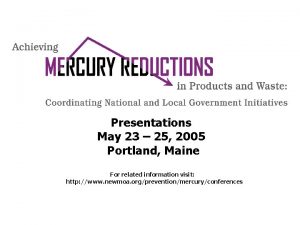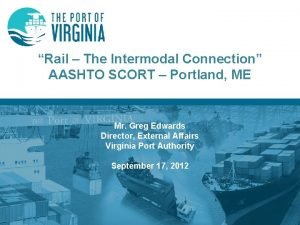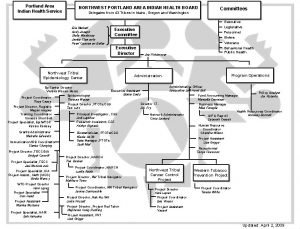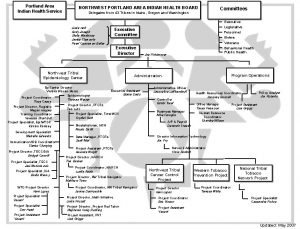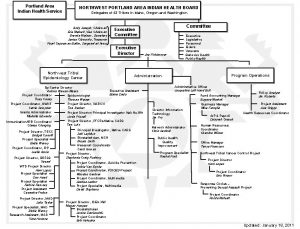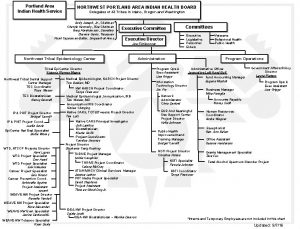AASHTO Spring Meeting Portland Maine May 2017 Jennifer






























- Slides: 30

AASHTO Spring Meeting Portland, Maine May 2017 Jennifer W. Macdonald AVP Government Affairs

State of the Railroad Industry • Safety Trends • Economic Outlook/Traffic • Regulatory Environment • Legislative Outlook SLIDE 2 ASSOCIATION OF AMERICAN RAILROADS

Freight Rail: Safe & Getting Safer RR Safety Trends: 2000 -2016 Train accident rate 43% Employee injury rate 47% Grade crossing collision rate 39% Hazmat accident rate* 63% *through 2015 SLIDE 3 Source: FRA, AAR ASSOCIATION OF AMERICAN RAILROADS

Safe and Getting Safer SLIDE 4 ASSOCIATION OF AMERICAN RAILROADS

PTC Implementation: On Track • Freight railroads spending $100 million/month on PTC • All equipment will be installed by end of 2018 • Fully operational by end of 2020 SLIDE 5 ASSOCIATION OF AMERICAN RAILROADS

Strong Correlation Between Growth in Rail Traffic and Goods-Related GDP 24% 18% 12% 6% 0% -6% -12% -18% -24% -30% (% change over previous year) GDP sectors that generate freight were essentially in recession in 2016 Goods-related GDP* Rail traffic** 2008 2009 2010 2011 2012 correlation = 97% 2013 2014 2015 2016 *Imports, exports, and personal consumption of goods; fixed residential investment; business investment in equipment & structures; government gross investment; and change in inventories. **U. S. carloads excluding coal and grain, plus intermodal units. Rail traffic is originations and does not include the U. S. operations of Canadian railroads. Source: BEA, AAR SLIDE 6 ASSOCIATION OF AMERICAN RAILROADS

Total U. S. Rail Carloads (6 -week moving average originations) 360, 000 340, 000 320, 000 2015 300, 000 280, 000 260, 000 2006 (peak year) 2017 240, 000 2016 220, 000 1 4 7 10 13 16 19 22 25 28 31 34 37 40 43 46 49 52 Week # Data do not include intermodal and do not include the U. S. operations of CN and CP. Source: AAR SLIDE 7 ASSOCIATION OF AMERICAN RAILROADS

Total U. S. Rail Carloads: YTD Through April (millions) 5. 6 5. 2 4. 8 4. 4 4. 0 3. 6 3. 2 2. 8 '09 '10 '11 '12 '13 '14 '15 '16 '17 Data are originations and do not include the U. S. operations of CN and CP. Source: AAR Rail Time Indicators SLIDE 8 ASSOCIATION OF AMERICAN RAILROADS

Sharp Decline in Rail Coal Carloads (millions) 7. 48 7. 71 6. 84 7. 07 7. 06 6. 20 5. 95 6. 11 5. 31 4. 19 2007 2008 2009 2010 2011 2012 2013 2014 2015 2016 Data are originated carloads for Class I railroads. Source: AAR (Freight Commodity Statistics) SLIDE 9 ASSOCIATION OF AMERICAN RAILROADS

U. S. Electricity Generation by Type of Fuel 55% 50% 45% 40% 35% 30% 25% 20% 15% 10% 5% 0% (% share of total generation, 2007 -2016) Coal Natural Gas Nuclear Hydro Renewables Source: Energy Information Administration SLIDE 10 ASSOCIATION OF AMERICAN RAILROADS

U. S. Rail Intermodal Traffic: YTD Through April (millions) 4. 6 4. 2 3. 8 3. 4 3. 0 2. 6 2. 2 '08 '09 '10 '11 '12 '13 '14 '15 '16 '17 Data are originations and do not include the U. S. operations of CN and CP. Source: AAR Rail Time Indicators SLIDE 11 ASSOCIATION OF AMERICAN RAILROADS

U. S. Rail Intermodal Traffic (average weekly originations) 290, 000 280, 000 2015 (peak year) 2017 270, 000 260, 000 250, 000 240, 000 2016 230, 000 220, 000 Jan Feb Mar Apr May Jun Jul Aug Sep Oct Nov Dec Data are average weekly originations for each month, are not seasonally adjusted, and do not include the U. S. operations of CN and CP. Source: AAR Weekly Railroad Traffic SLIDE 12 ASSOCIATION OF AMERICAN RAILROADS

Rapid Intermodal Growth (millions) 14 12 10 8 Containers 6 4 2 Trailers 0 '84 '88 '92 '96 '00 '04 '08 '12 '16 Source: AAR Weekly Railroad Traffic SLIDE 13 ASSOCIATION OF AMERICAN RAILROADS

Containers vs. Trailers as % of U. S. Rail Intermodal Traffic 100% 90% 80% 70% 60% 50% 40% 30% 20% 10% 0% Trailers Containers '90 '92 '94 '96 '98 '00 '02 '04 '06 '08 '10 '12 '14 '16 Source: AAR (Weekly Railroad Traffic) SLIDE 14 ASSOCIATION OF AMERICAN RAILROADS

Characteristics of the Intermodal Network Must accommodate both domestic and international business Focused on high volume origin-destination pairs Best when operated as single origin to single destination trains Cost control and service reliability are critical SLIDE 15 ASSOCIATION OF AMERICAN RAILROADS

Characteristics of Strong Intermodal Corridors Sufficient capacity to keep trains moving Long enough to compete with trucks Sufficient volume to keep unit costs competitive Strong highway feeder system at each end at intermediate terminals SLIDE 16 ASSOCIATION OF AMERICAN RAILROADS

Characteristics of the Newest Intermodal Terminals Usually outside urban areas Easy highway access Designed to accommodate adjacent distribution / production centers Land for future growth Minimize “on terminal” truck movements SLIDE 17 ASSOCIATION OF AMERICAN RAILROADS

U. S. Rail Carloads + Intermodal Traffic: 2007 -2016 (millions) 30 29 28 27 26 25 24 23 22 21 '07 '08 '09 '10 '11 '12 '13 '14 '15 '16 Data are originations and do not include the U. S. operations of CN and CP. Source: AAR Weekly Railroad Traffic SLIDE 18 ASSOCIATION OF AMERICAN RAILROADS

Total U. S. Rail Carloads + Intermodal Traffic 620, 000 600, 000 580, 000 560, 000 540, 000 520, 000 500, 000 480, 000 460, 000 (6 -week moving average originations) 2006 (peak year) 2017 2015 2016 1 4 7 10 13 16 19 22 25 28 31 34 37 40 43 46 49 52 Week # Data do not include the U. S. operations of CN and CP. Source: AAR Rail Time Indicators SLIDE 19 ASSOCIATION OF AMERICAN RAILROADS

Railroads and International Trade SLIDE 20 ASSOCIATION OF AMERICAN RAILROADS

RRs and International Trade: Summary Statistics ~50, 000 rail jobs — worth over $5. 5 billion in annual wages and benefits — depend directly on international trade SLIDE 21 ASSOCIATION OF AMERICAN RAILROADS

U. S. Rail Revenue From International Trade Rail movements associated with international trade include virtually every type of commodity railroads carry and involve every region of the country. SLIDE 22 ASSOCIATION OF AMERICAN RAILROADS

Railroads Help Keep Coal. Based Electricity SLIDE 23 ASSOCIATION OF AMERICAN RAILROADS

Railroads Help Keep Coal. Based Electricity SLIDE 24 ASSOCIATION OF AMERICAN RAILROADS

Legislative Agenda • Regulatory Reform • Tax Reform • Infrastructure Package • Trade SLIDE 25 ASSOCIATION OF AMERICAN RAILROADS

Regulatory Reform • • SLIDE 26 Regulations Executive Orders Safety Advisories Guidance ASSOCIATION OF AMERICAN RAILROADS

Corporate Tax Reform • Class 1 railroads pay on average 33% federal tax rate. • When you add state and local taxes, the effective tax rate is 37%. • U. S. corporate tax rate is the highest in the industrialized world SLIDE 27 ASSOCIATION OF AMERICAN RAILROADS

Infrastructure Initiative • Freight railroads are spending an average of $60 million/day on infrastructure and equipment • State-freight rail partnerships leverage federal investment SLIDE 28 ASSOCIATION OF AMERICAN RAILROADS

Truck Size and Weight Redux • Effort underway to increase truck weights on interstates to 91, 000 lbs. • 15 -year pilot for 10 states. • SHIP Coalition (Safer Hauling & Infrastructure Protection) • House floor vote on this same issue in 2015 – defeated 236 -187. SLIDE 29 ASSOCIATION OF AMERICAN RAILROADS

www. aar. org www. freightrailworks. org (202) 639 -2100 30 Association of 6/8/2021
 Walters restaurant portland maine
Walters restaurant portland maine Hard rock maine
Hard rock maine Ch robinson dispatch
Ch robinson dispatch Dhhs portland maine
Dhhs portland maine Scortportland
Scortportland Aashto lrfd 2017
Aashto lrfd 2017 Aashto annual meeting 2015
Aashto annual meeting 2015 Wayne smith csun
Wayne smith csun Ftp server spring 2017
Ftp server spring 2017 What months are in spring
What months are in spring Spring, summer, fall, winter... and spring (2003)
Spring, summer, fall, winter... and spring (2003) Job meeting bari 2017
Job meeting bari 2017 Nrg oncology meeting 2016
Nrg oncology meeting 2016 Nrg oncology semiannual meeting 2021
Nrg oncology semiannual meeting 2021 Joanne chien
Joanne chien American epilepsy society annual meeting 2017
American epilepsy society annual meeting 2017 Nrg oncology semi annual meeting 2018
Nrg oncology semi annual meeting 2018 Design parameters
Design parameters Spring safety topics
Spring safety topics Types of meeting
Types of meeting Today meeting or today's meeting
Today meeting or today's meeting Today meeting or today's meeting
Today meeting or today's meeting What is meeting and types of meeting
What is meeting and types of meeting Aashto manual for assessing safety hardware
Aashto manual for assessing safety hardware Aashto clear zone
Aashto clear zone Sucs
Sucs Aashto rac
Aashto rac Aashto geometric design
Aashto geometric design Lapis pondasi agregat kelas b
Lapis pondasi agregat kelas b Aashto method
Aashto method Aashto comp
Aashto comp


